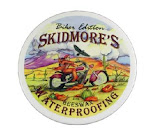You just spent a small fortune on a pair of leather gloves or boots. What can you do to keep them in good order?
Start out the way you mean to go on and give them a good coat of Skidmore's Biker Edition Leather Cream as soon as you get them home. This stuff was created to keep cowboy leather supple and is made in Montana, USA. You can be sure it works. Finish off with a light coat of Skidmore's and you are set to go
Try to resist the urge to wear your new gloves and boots in bed and let the cream soak in properly overnight. It is based on beeswax so there is nothing nasty going to happen to your leather. It will just be a tad more supple and a lot more waterproof right from the start.
Keep it clean!
Follow the instructions below for cleaning your leather any time it gets covered in mud and always give it a good coat of Skidmore's before you put it in store for the winter.
Wadda ya mean you ride all year round? All year round protection is easy 'cos all you need to do is clean off the clag and apply Skidmore's on a regular basis. Even if you only give your leather two coats a year you will prolong its life and make it more weather resistant. It has to be worth an occasional fifteen minutes of your life to save spending all that money again.
Repairs
Check your gear regularly and keep an eye open for loose threads on your gloves and boots. If you spot something unravelling take a minute to drop into your local repair shop and get it sorted out.
Much of the leatherwork you will find has been machine stitched. It is often difficult to match this with hand stitched work. If you want to replace 'like with like' you will need to look around and try to find an 'old school' repair shop with the ability to match the stitches.
Hand stitching:
First clean out all the old thread from the area that needs to be repaired. Use a pair of tweezers to ensure the job is properly clean before you start. A scalpel is useful to cut away loose threads.It is possible to find strong threads in various colours and sizes similar to those used by the original machinists but it is essential to make as good a match as possible if the repair is to look respectable.
Having cleaned out the stitch holes, and using two blunt harness makers needles - threaded one on each end of a length of beeswaxed thread - carefully start to restitch the damaged area. Do not use sharp embroidery needles as these can damage the leather fibres and are harder to work with.
First pass the thread through the stitch holes until you have an even amount each side. Then take one needle and pass it halfway back through the work and take the other needle and do the same.
Grasping both needles, one in each hand, pull them through the work and tighten the thread to make a stitch. Be careful not to pull the thread too hard as the leather will tear through very easily. Continue until you have made the repair. To finish the job, simply back stitch two or three holes and cut the loose ends off close to the work.
Repairs to most motorcycle gloves (excluding the heated variety) are relatively easy and shouldn't be too expensive but boots can be tricky. If it isn't obvious how to fix something then check out your local leather repair shop before it gets any worse.
Vehicle restoration projects welcomed - telephone 01584 873633
Skidmore's Restoration Cream
Skidmore's Beeswax Waterproofing Cream (Biker Edition) and Skidmore's Restoration Cream are both available online at www.barefootleather.co.uk/leatherworking/Leather-treatments - I have some exceptionally fine belts and bags too!




